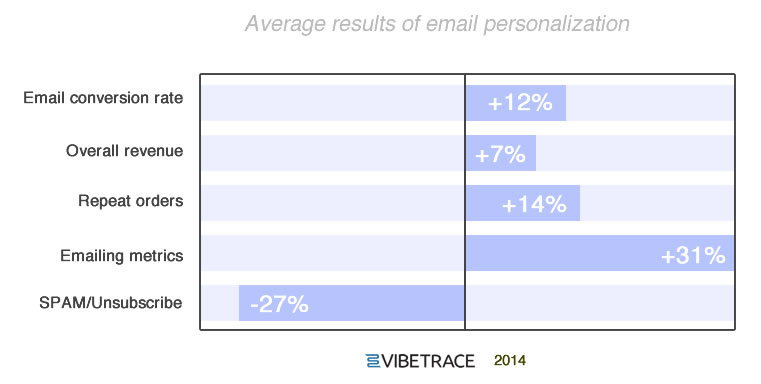The most basic form of email personalization is including recipient’s name in the subject line. Next step is developing a unique email for each subscriber, with completely personalized content.
In between these two options, there is a large range of email personalization ideas that you can use for improving your email marketing campaigns. Ecommerce is a wonderful world that allows you as a marketer to be as creative as you want and to use advanced emailing tools available on the market.
If you have already segmented your target audience, that puts you on the right track for having a relevant communication with the main 3 target segments: your customers, your potential customers and inactive subscribers.
Another source to gather personalization data is user activity, profile information and purchase history. While would be great to mix all those together, the results are very satisfactory only using one at a time.
Which emailing topics trigger the interest of your 3 segments?
Current customers respond positively to:
- A thank you email after they bought something on your ecommerce platform
- Your support if they have questions or problems with the product
- Your interest in their customer satisfaction
- Your offer of other products or services from their interest range
- An invitation to become a loyalty club member
- A request to share their purchases and preferences on social media
Potential customers are intrigued by:
- Relevant information about the products and services which match their interests
- Interesting promotions which encourage them to check out your ecommerce website and make a first purchase
- Information about your company that helps them know you and trust you
Some triggers for re-becoming friends with your inactive subscribers are:
- An email with special offers. Everybody loves a good promotion!
- A presentation of your new entries. If older products did not trigger their interest, the new arrivals might do the job.
How to actually personalize your emails?
Email personalization is an area with endless possibilities. You can surely imagine tens of ways to customize your emails, like a matrix with combinations of all data sources.
There are a few things you can personalize inside an email:
- simple text tags (like user name, or location, or gender)
- banners (images that are different by customer segment)
- product recommendations (products most likely to be bought by each user).
The last two are also known as dynamic content.
We will point out below 5 email personalization tactics which are already successfully used by our clients and other ecommerce companies.
1. Say the recipient’s name
If you know your subscribers’ names, use them. Otherwise, why did you bother making them fill out that form anyway? It’s nice to address people by their names and it’s quite handy too.
A personalized subject line might increase the open rates with up to 30%. Unless you operate in a business which is very much linked to data protection policies and you think that your customers might feel exposed getting a very custom email…
2. Demographics related content. Age, gender, location…
I know, you have s shinny mini-dress you want to sell because you have a huge margin. But would you see your grandma buying it? NO. Or would you sell gloves and scarfs to people in California?
Those examples are exagerated, but I think you got my point. Age, gender and location are the most important segments for email personalization.
Hint: use banners to display specific promotions to each user group.
3. Product recommendations inside email
Dynamic content is a tool in which large elements of the email creative are changed based on complex rules. In an ecommerce newsletter where you have rows of products, every product in the template can meet interests of each users.
Because this cannot be done manually, we’ll refer it as a tool.
Hint: recommend them products based on the last purchase. For example promote filters and bags if they bought a vacuum cleaner.
4. Create different landing pages too
The personalized experience of each of your customers should go on until the very next step. If the recipient of your email clicks though the links you’ve inserted in the content, then take their journey further to pages with relevant information. Create landing pages prepared especially for the banner they’ve clicked.
5. Use marketing automation tools and nurture leads
Marketing automation brings email marketing and email personalization in a new age. With marketing automation, you don’t only make the emails unique per segment. You make them unique per customer, according to their preferences and behavior.
Benefits of email personalization
Here is a graphic with benefits of email segmentation and personalization. The results were gathered from all our customers after 1 month of using Vibetrace Ecommerce Email Marketing.

